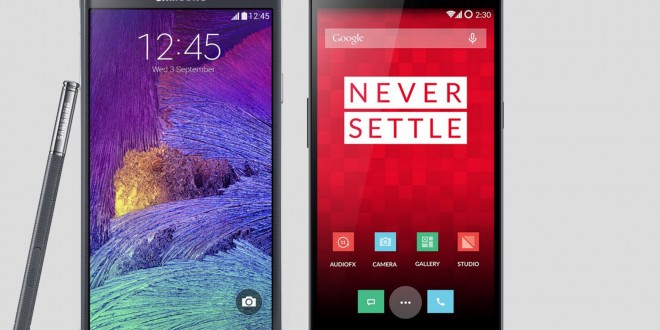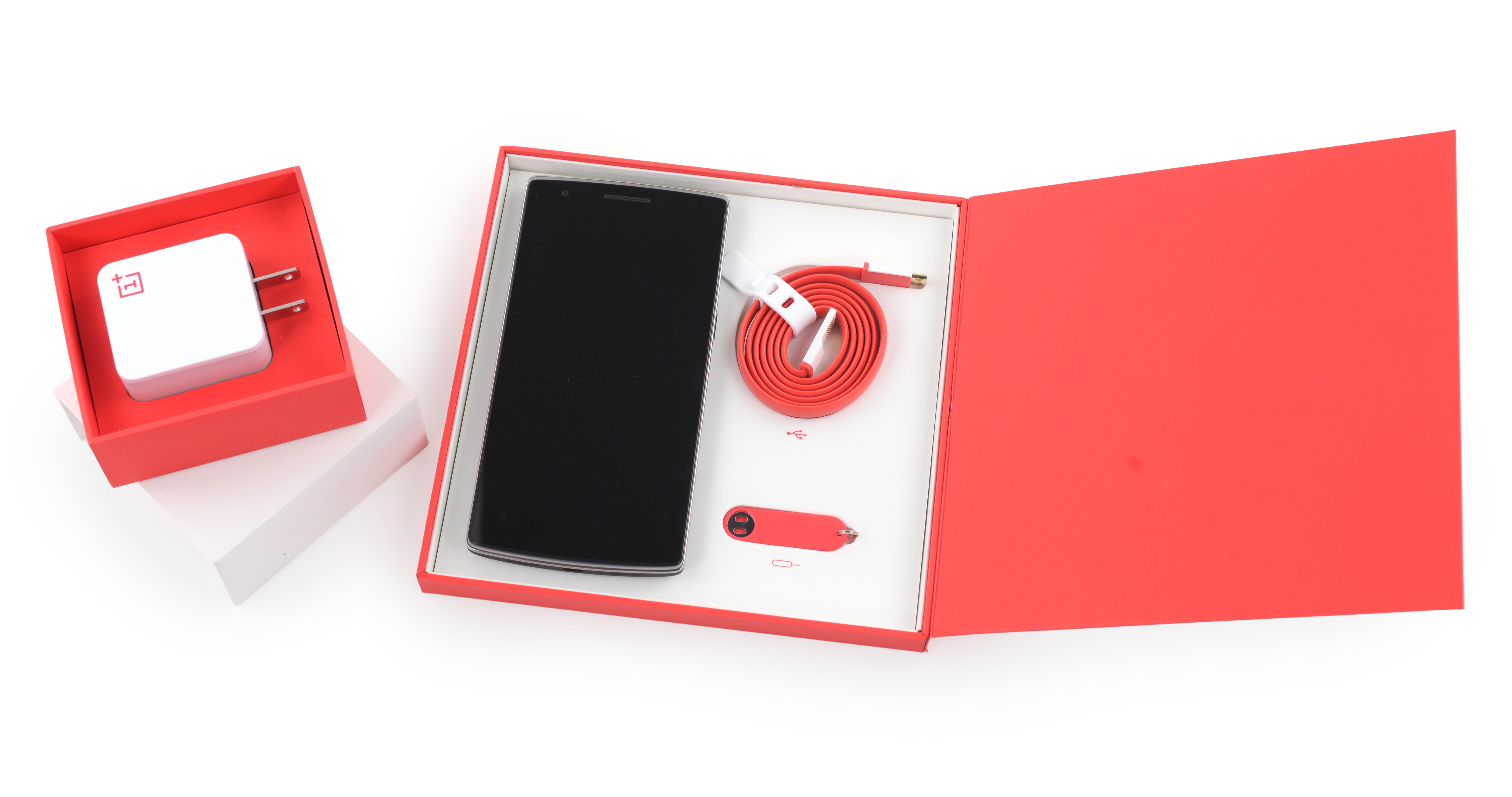Since the Samsung Galaxy Note 4 has just gone up for sale in retail stores and carriers in different countries, the time is opportune to review what this phablet from Samsung is capable of doing. On the other hand, the OnePlus One flagship killer will be up for sale at the end of next month, so some of you might be wondering whether you should rush to buy the Galaxy Note 4 or wait a bit for the OnePlus One – and save a lot of money.
The main issue with the Galaxy Note 4 in comparison to the OnePlus One and other affordable smartphones like the Xiaomi Mi4, Oppo Find 7 and Meizu MX4 is that the price tag on Samsung’s phablet is rather hefty. That doesn’t mean that the Galaxy Note 4 is overpriced, as you will come to understand after reviewing its specs and design, but it is a device aimed at those who can muster up quite a lot of cash for a smartphone. There’s always the option of getting the Galaxy Note 4 with a two-year contract at a carrier, but I’d rather not recommend that, because binding your phone to a carrier has many downsides, as I’m sure many of you are aware of.
The question to ask in this situation is which one would you prefer if you weren’t constrained by a budget. This comparison between the OnePlus One and the Galaxy Note 4 aims to answer that question as best as possible by describing all the great features and the drawbacks of each handset. Ultimately, if you’re on a budget, the $300 or $350 price tag on the OnePlus One should be enough to convince you to drop the Galaxy Note 4 and its $720 price at Sprint, for the unlocked version.
If you’re not constrained by a budget, you should still check out both of these flagships, because both of them have been well-regarded by many tech enthusiasts, the OnePlus One getting the “flagship killer” nickname, whilst the Galaxy Note 4 is considered to be the smartphone with the best screen you can find on the market. Truth is, both phones are high-end premium smartphones that can rival with the likes of the Vertu line in design and functionality, although their build doesn’t use materials that are quite as luxurious as the leather and diamonds on the Vertu Aster or Signature Touch.
Since the Galaxy Note 4 is supposed to have the best display you can find, let’s start by comparing the screen on the Galaxy Note 4 to that on the OnePlus One. The Galaxy Note 4 has a 5.7 inch Super AMOLED screen with a 1440*2560 resolution and 518 ppi pixel density. That screen size makes the Galaxy Note 4 a phablet, rather than a smartphone, to be truthful. Reviewers of the Galaxy Note 4 say that the screen is bright, vibrant, vivid, clear and has awesome contrasts rates, outdoor visibility and color reproduction. The OnePlus One has a slightly smaller, 5.5 inch LTPS LCD screen with 1080*1920 resolution and 401 ppi pixel density. The OnePlus One is also bordering the phablet category, but it doesn’t offer as good a screen as the Galaxy Note 4 does. The OnePlus One still has a great screen with excellent ppi and you will only notice a slight difference between the two screens. Nonetheless, in the display quality category, the Galaxy Note 4 is the clear winner.
The phablet trend that has taken hold of the smartphone market at the moment may not sit well with a certain segment of customers. Some of you might argue that buying a powerful, high quality device is futile if you’re not able to maneuver the device accordingly. I agree on this matter, and can safely say that I would rather choose the OnePlus One or the LG G3 5.5 inch screen than the 5.7 inch screen on the Galaxy Note 4, if that were to help me actually fit the device in my pocket and wield it with my smaller than average hands. The Sony Xperia Z3 or Z2 with their 5.2 inch screen would do better, but ultimately, I would rather go for the Samsung Galaxy S5 with its 5.1 inch display, or the 5 inch HTC Butterfly 2 or the HTC One M8. Nonetheless, for those of you who are not bothered by phablets, the Galaxy Note 4 will fit you perfectly.
To be fair, there’s not even that much of a difference in the device size, when it comes to the Galaxy Note 4 and the OnePlus One. The Galaxy Note 4 measures 153.5 mm in height, 78.6 mm in width and 8.5 mm in thickness. The OnePlus One measures 152.9 mm in height, 75.9 mm in width and 8.9 mm in thickness. Ultimatily, Samsung managed to fit the 5.7 inch display into a device with thin bezels so that when put next to each other, the OnePlus One and Galaxy Note 4 almost look the same. The OnePlus One is lighter a bit than the Galaxy Note 4, with 162 grams versus the 176 grams the Galaxy Note 4 weighs. That being said, in terms of maneuverability, the Galaxy Note 4 and OnePlus One have reached a tie, in my mind. Both are a little big for me, but I would go for the OnePlus One because it’s a bit lighter and just a bit smaller. Nonetheless, the Galaxy Note 4 packs a bit more screen into almost the same size, so it actually doesn’t matter that much.
Design-wise, Samsung has outdone itself with the Galaxy Note 4, Note Edge and the Galaxy Alpha, by responding to users’ complaints about the Galaxy S5 feeling cheap and flimsy. The Galaxy Note 4 build is made of metal and features a faux leather back, rather than the polycarbonate chassis on the Galaxy S5. The OnePlus One has a soft-touch back which feels great in the hand, metal build, rounded edges and flat back. Design-wise, both the flagships are high-end, look great and feel great, so it’s up to you to choose which button placement you enjoy, which type of back cover you would rather touch all day and which weight you would rather be carrying around.
So far, the Galaxy Note 4 has demonstrated that it has one of the best displays you can find on the market, but the OnePlus One is also among the more high-end screens you may be able to buy at the moment. The design of the two smartphones doesn’t differ that much, although the Galaxy Note 4 fits more screen into the same form factor. These categories are not that important though, in my mind. Not to say that display or size doesn’t matter, but it’s not necessarily the main quality a smartphone can boast with. Specs are most important in my mind, and how they blend in with the OS you run on your phone, and what performance you can get out of your device.
Let’s get right into it. The Galaxy Note 4 is powered by a quad core Snapdragon 805 CPU or Samsung’s octa core Exynos 5433 CPU. The Snapdragon 805 CPU is clocked at 2.7 GHz and backed by an Adreno 420 GPU and 3 GB RAM, whilst the Exynos CPU has a Mali-T760 GPU backed by the same amount of RAM. The Galaxy Note 4 comes with only a 32 GB version, but you do have a microSD card slot of that space will not be enough for you. The OnePlus One is slightly inferior in processing power, running on a quad core Snapdragon 801 CPU clocked at 2.5 GHz, backed by Adreno 330 GPU and 3 GB RAM. You can get the One with either 16 or 64 GB storage configurations, but with no microSD card slot available. Performance wise, both phones have been reported to be running great. The Galaxy Note 4 does have a stronger and newer processor, but the OnePlus One still runs as fast as the Galaxy Note 4. The difference is that the OnePlus One might occasionally encounter a bit of lag, whilst that hasn’t been reported on the Galaxy Note 4 yet. Extensive testing hasn’t been done on the Galaxy Note 4, so this is not a definite verdict, because benchmarks don’t actually reflect real-life use of a smartphone.
Considering the specs written on paper, the Galaxy Nore 4 should run circles around the OnePlus One, but truth is that smartphones can only do so much and there aren’t many extremely power-hungry apps and features out there. The OnePlus One will struggle a bit more with graphics-intensive games that the Galaxy Note 4, but ultimately, if you’re looking for performance, either phone will offer you top-notch.
The camera on the Galaxy Note 4 is slightly better than that on the OnePlus One, with a 16 MP wide-angle sensor, featuring optical image stabilization, LED flash, autofocus, dual shot, simultaneous HD video and image recording, geo-tagging, touch focus, face and smile detection, panorama and HDR, naturally. The front facing shooter on the Galaxy Note 4 is a 3.7 MP sensor. The OnePlus One sports a 13 MP rear camera with a dual-LED flash, geo-tagging, autofocus, touch focus, face detection, HDR and panorama. The front facing shooter on the One is slightly better than on the Galaxy Note 4, featuring a 5 MP sensor which can take better selfies than the Galaxy Note 4 can. Having detailed the camera specs, the Galaxy Note 4 will definitely take better pictures because of the OIS features.
Nonetheless, the One exceeds many other smartphones out there in picture quality and detail as well, so it’s not like you’re getting a bad camera on the device. Still, both phones have great camera apps that allow for many types of customization, so you should definitely check out some camera samples from both the flagships if you decide to weigh your choices based on camera performance. I don’t care much about smartphone cameras, because I honestly don’t really take photos that much, so I would rather not say which one I would choose based on camera features, because I honestly don’t care about them. This is where you come in and decide for yourself based on your needs: is a very good camera a necessity for you? If so, go for the Galaxy Note 4. Are you content with a pretty good camera at a very low price? The OnePlus One should be your first choice, then.
The batteries on the OnePlus One and Galaxy Note 4 don’t differ that much, with 3100 mAH and 3220 mAH, respectively. Since the Galaxy Note 4 has quite a deal more pixels to power on that 5.7 inch Super AMOLED screen, it’s most likely that the battery life on the device will take a blow in testing, but since there hasn’t been any comprehensive battery testing done, I’d rather not say for sure. The OnePlus One has an average battery life, requiring a charge at the end of the day, but lasting for a day and a half if not extensively used. If battery life is important to you, and I’m sure it is, you should keep your socks on and wait for reviewers to give some concrete information on how well the Galaxy Note 4 battery handles all that screen. The battery on the Galaxy Note 4 is removable, so that’s a plus compared to the OnePlus One’s non-removable one.
Last, but not least, we should talk about features. First off, the Galaxy Note 4 has a fingerprint sensor and an S Pen stylus which will come in handy for those of you who take lots of notes and work on art projects on your phones. NFC, Bluetooth and Wi-Fi are featured on both flagships, but the Galaxy Note 4 has the added benefit of an IR blaster, LTE Cat 6, quick charge, heart rate sensor, UV sensor, oxygen saturation sensor and mini HDMI out. Compared to all these extra features, the OnePlus One seems rather dull, being able to boast with the customizable CyanogenMod 11S UI which is far more interesting than the TouchWiz on the Galaxy Note 4. The Galaxy Note 4 runs TouchWiz on Android 4.4.4 KitKat whilst the OnePlus One runs CyanogenMod 11S on Android 4.4.2 KitKat.
If you’re looking for a phablet filled with different features you can show off and think you will actually use in real-life situations, the Galaxy Note 4 should be your perfect choice. But if you’re like me and would rather dump the heart rate sensor, fingerprint sensor and TouchWiz and would rather have a phone that focuses more on basic functions you can actually use day-to-day, the OnePlus One will suit you better and will save you some cash, too. Overall, the Galaxy Note 4 is the winner of this comparison, with many more features, better screen, better processor and the S Pen which trump the more bland setup of the OnePlus One. Nonetheless, the OnePlus One still remains the flagship-killer, because it truly is a high-end smartphone that will cater to most power users out there, being able to do all the task you will need it to. That is, if you don’t need a heart rate sensor, a remote control function or fingerprint authentication.
 Load the Game Video Games, Reviews, Game News, Game Reviews & Game Video Trailers
Load the Game Video Games, Reviews, Game News, Game Reviews & Game Video Trailers





